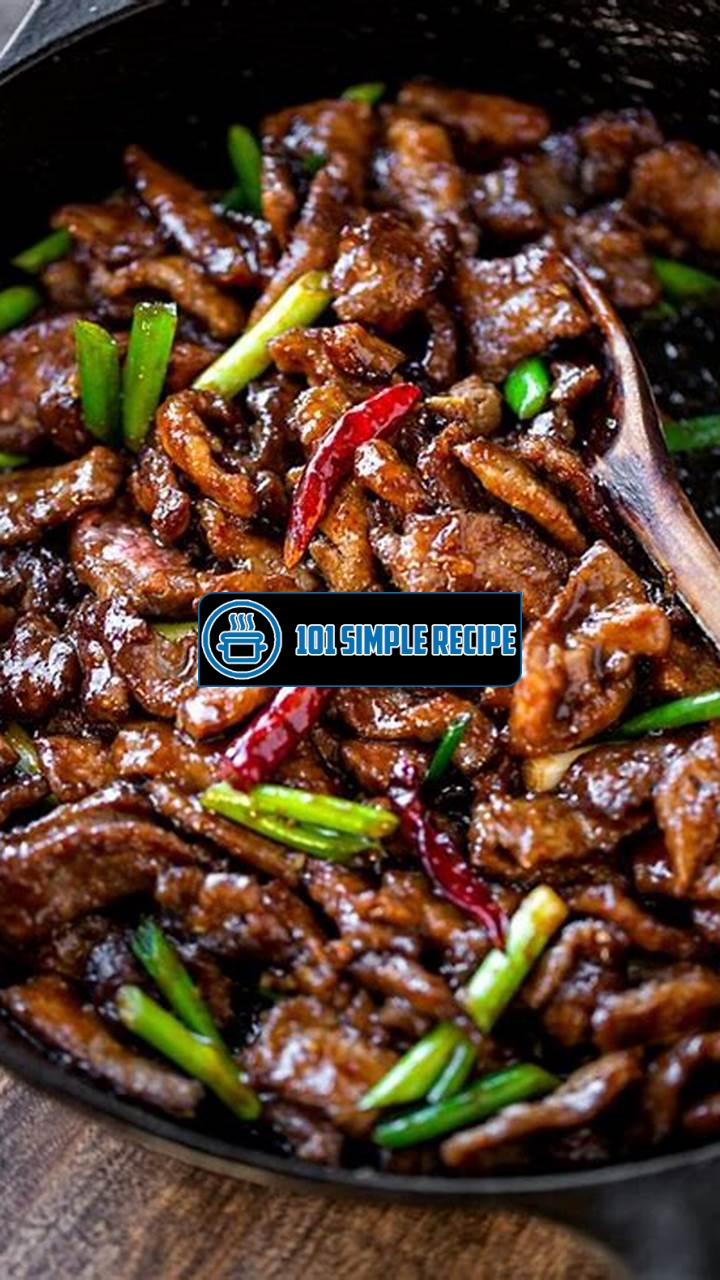Are you craving the perfect combination of savory and sweet? Look no further than this Delicious Chinese Mongolian Beef Recipe . This mouthwatering dish is a classic in Chinese cuisine, known for its bold flavors and tender strips of beef. Whether you’re a fan of Asian cuisine or just love trying new recipes, this dish is sure to satisfy your taste buds. Get ready to indulge in a hearty meal with a touch of Asian flair.

Exploring the Flavors of Chinese Mongolian Beef
Discover the rich and savory flavors of the popular Chinese dish, Mongolian Beef, and learn how to recreate it in your own kitchen.
The Origin of Mongolian Beef
Mongolian Beef is a delicious Chinese dish that has gained popularity worldwide. Despite its name, it does not originate from Mongolia. In fact, the dish is believed to have been created in Taiwanese and American Chinese cuisines. It was likely named after Mongolian barbecue, which is a cooking style that originated in Taiwan. Mongolian barbecue involves stir-frying various meats, vegetables, and sauces on a large metal plate, giving diners the ability to customize their own meals.
The Key Ingredients of Mongolian Beef
Mongolian beef typically consists of thinly sliced beef, green onions, and a savory sauce. The beef used in this dish is usually flank steak, which is known for its tenderness and flavor. Other ingredients commonly found in Mongolian beef include soy sauce, hoisin sauce, garlic, ginger, and brown sugar. These ingredients contribute to the overall umami taste of the dish and add depth of flavor.
The Art of Marinating
One of the key steps in preparing Mongolian beef is marinating the meat. Marinating helps tenderize the beef and infuse it with flavor. To marinate the beef, you will need a mixture of soy sauce, hoisin sauce, minced garlic, minced ginger, and brown sugar. The beef should be thinly sliced and then placed in the marinade for at least 30 minutes or up to overnight in the refrigerator. This allows the flavors to penetrate the meat and make it more tender.
Pro Tip: To add extra flavor to your Mongolian beef, you can also marinate the meat with other ingredients such as oyster sauce, sesame oil, or chili paste. Experiment with different combinations to find your favorite flavor profile.
Once the beef has been marinated, it can be stir-fried along with the green onions and sauce. The beef is typically cooked until it is browned and slightly crispy on the edges. The green onions add a fresh and aromatic element to the dish.
Mongolian beef is often served with steamed rice or noodles, allowing you to enjoy the flavorful sauce alongside the tender beef. The combination of the savory sauce, tender beef, and aromatic green onions makes Mongolian beef a truly delicious and satisfying dish.
Pro Tip: For added texture and crunch, you can garnish your Mongolian beef with toasted sesame seeds or chopped peanuts.
Exploring the flavors of Chinese Mongolian Beef allows you to experience the richness and savory nature of this popular dish. By understanding its origin, key ingredients, and the art of marinating, you can recreate this delicious dish in your own kitchen. Remember to have fun experimenting with different flavors and ingredients to make the dish uniquely yours. Enjoy!
Mastering the Cooking Techniques
If you want to prepare the perfect Chinese Mongolian Beef dish, it is essential to master the cooking techniques required. By understanding and practicing these techniques, you can elevate your cooking skills and create a flavorful and authentic Mongolian Beef dish that will impress your family and friends.
Stir-Frying: The Foundation of Mongolian Beef
Stir-frying is the foundation of Mongolian Beef and is crucial to achieving the desired flavors and textures. This cooking technique involves quickly cooking small pieces of meat and vegetables in a hot pan or wok. It requires high heat, constant stirring, and a short cooking time to preserve the crispness of the ingredients and maintain their natural flavors.
To stir-fry Mongolian Beef, start by heating a tablespoon of oil in a preheated wok or large skillet. Make sure the oil is hot before adding the thinly sliced beef. Cook the beef for a few minutes until it is browned and cooked through. Remove the beef from the pan and set it aside.
Next, add your choice of vegetables to the hot pan and stir-fry them for a few minutes until they are tender but still crunchy. Common vegetables used in Mongolian Beef include bell peppers, onions, and green onions. Once the vegetables are cooked to your liking, return the cooked beef to the pan and toss everything together.
- Stir-frying is the foundation of Mongolian Beef.
- Stir-fry the beef until it is browned and cooked through.
- Add your choice of vegetables and stir-fry until tender.
- Toss everything together for a perfect Mongolian Beef dish.
The Art of Creating a Velveting Marinade
Another important technique in preparing Mongolian Beef is marinating the meat to achieve tenderness and flavor. The Chinese cooking technique of velveting is often used to accomplish this. Velveting involves marinating the beef in a mixture that usually includes soy sauce, cornstarch, and sometimes egg white. The marinade helps tenderize the meat, resulting in a succulent and velvet-like texture.
To create a velveting marinade for Mongolian Beef, combine soy sauce, cornstarch, and egg white in a bowl. Whisk the ingredients together until they are well combined. Then, add the thinly sliced beef to the marinade and toss until the meat is evenly coated. Let the beef marinate for at least 30 minutes to allow the flavors to infuse and the meat to become tender.
After the marinating process, remove the beef from the marinade and gently shake off any excess. The beef is now ready to be stir-fried or cooked according to your recipe. The velveting marinade adds depth of flavor and enhances the overall taste of the Mongolian Beef dish.
- Velveting is a marinating technique used in Mongolian Beef.
- The marinade consists of soy sauce, cornstarch, and egg white.
- Let the beef marinate for at least 30 minutes.
- Shake off the excess marinade before cooking.
Searing and Saucing for Maximum Flavor
To achieve maximum flavor in your Mongolian Beef dish, it is essential to master the techniques of searing and saucing. Searing involves cooking the beef at high heat to create a caramelized crust, while saucing adds a rich and savory element to the dish.
Start by searing the marinated beef in a hot pan or wok. Heat oil in the pan until it is smoking hot, then add the beef and cook it for a few minutes on each side until it develops a desirable brown crust. Searing the beef locks in the juices and enhances the flavor of the final dish.
After searing the beef, it’s time to sauce it up. Mongolian Beef is typically served with a thick and flavorful sauce that coats the meat and vegetables. Common ingredients for the sauce include soy sauce, hoisin sauce, ginger, garlic, and brown sugar. Mix these ingredients together in a bowl, then add the sauce to the pan with the seared beef. Stir everything together to ensure that the beef and vegetables are evenly coated with the delicious sauce.
- Searing creates a caramelized crust on the beef.
- Cook the beef on each side until it develops a brown crust.
- Sauce the beef with a mixture of soy sauce, hoisin sauce, ginger, garlic, and brown sugar.
- Stir everything together for a flavorful Mongolian Beef dish.
By mastering the cooking techniques of stir-frying, creating a velveting marinade, and searing and saucing, you can prepare a delicious and authentic Mongolian Beef dish that will impress your taste buds. Remember to experiment with different ingredients and adjust the flavors according to your preferences. Enjoy your culinary journey in mastering the art of Chinese Mongolian Beef!
If you’re looking for a tasty side dish to serve with your Mongolian Beef, try these Kaiser Rolls. They’re soft and buttery, and they pair well with any meat dish.
Customizing Your Mongolian Beef Dish
Discover how you can personalize your Chinese Mongolian Beef by adding unique ingredients and flavors to suit your taste.
Adding Vegetables for a Nutritious Twist
When it comes to customizing your Mongolian Beef dish, adding vegetables can not only enhance its nutritional value but also provide a delightful twist to the traditional recipe. Incorporating colorful and nutrient-rich vegetables not only adds a pop of color to your dish but also introduces a range of flavors and textures. From crunchy bell peppers to tender broccoli florets, there is a multitude of options to elevate your Mongolian Beef to a whole new level!
To get started, consider adding sliced bell peppers in vibrant hues like red, green, and yellow. These peppers not only add a refreshing crunch to the dish but also provide a burst of flavor and essential vitamins. You can experiment with different colors and explore the unique taste each variety brings to your Mongolian Beef.
Another great vegetable choice is broccoli. Rich in vitamins and fiber, broccoli can add a healthy twist to your beef dish. Blanch the broccoli florets, and then stir-fry them with your beef and sauce. The result is a flavorful combination that is both nutritious and satisfying.
To amp up the nutrition even further, why not throw in some baby carrots? These sweet and crunchy gems are packed with beta-carotene and can serve as a delightful addition to your Mongolian Beef. From sliced carrots to baby corn, the possibilities are endless.
Pro tip: Don’t be afraid to get creative and experiment with other veggies like snap peas, bok choy, or even shredded cabbage. They can add unique flavors and textures that will elevate your Mongolian Beef to the next level!
Experimenting with Spices and Seasonings
Spices and seasonings play a crucial role in elevating the taste profile of your Mongolian Beef dish. By experimenting with different spices, you can create a delightful symphony of flavors that suits your palate. From mild and aromatic spices to intense and fiery ones, the choice is yours!
One popular spice to consider is garlic. Known for its pungent and distinctive flavor, garlic adds depth and complexity to any dish. Infuse your Mongolian Beef with minced garlic to enhance its savory profile and create a mouthwatering experience.
If you’re a fan of heat, you can add a pinch of red pepper flakes or a few slices of fresh chili peppers to give your beef dish a spicy kick. The heat will complement the richness of the sauce and add an exciting dimension to each bite.
For those who prefer a fragrant and earthy flavor, try incorporating some fresh ginger into your Mongolian Beef. Ginger adds a subtle warmth and a hint of sweetness that pairs beautifully with the umami flavors of the dish.
Pro tip: Don’t be afraid to mix and match different spices and seasonings to create your signature flavor. From Chinese five-spice powder to soy sauce and hoisin sauce, there are endless possibilities to explore!
Exploring Alternative Proteins for Variations
While traditional Mongolian Beef typically features thinly sliced flank steak, there are plenty of alternative proteins you can experiment with to create exciting variations of this classic dish.
One option to consider is using boneless chicken thighs instead of beef. The succulent and tender texture of chicken thighs pairs exceptionally well with the bold flavors of Mongolian sauce. Simply slice the chicken thighs into thin strips and stir-fry them until they are cooked through. The result is a satisfying and flavorful alternative to the beef version.
If you’re looking for a lighter option, why not try shrimp? Shrimp adds a delightful sweetness to the dish and cooks quickly, making it an excellent choice for a quick and flavorful meal. Stir-fry the shrimp with the sauce and vegetables for a mouthwatering seafood twist.
For those who prefer plant-based proteins, tofu can be a fantastic alternative. Firm tofu can easily absorb the flavors of the sauce and spices, creating a delicious meatless version of Mongolian Beef. Simply cube the tofu and stir-fry it with your favorite veggies and seasonings.
Pro tip: Feel free to get creative with alternative proteins based on your dietary preferences and taste preferences. From thinly sliced pork to seitan or even tempeh, the possibilities are endless!
Serving and Pairing Suggestions
Uncover the best ways to present and serve your Chinese Mongolian Beef for an unforgettable dining experience.
Creating a Stunning Presentation
When it comes to serving Chinese Mongolian Beef, presentation is key. A visually appealing dish can enhance the dining experience and leave a lasting impression. To create a stunning presentation, you can follow these tips:
- Garnish with Fresh Herbs: Adding a sprinkle of fresh cilantro or green onions on top of your Mongolian Beef can add a pop of color and freshness. It also adds a subtle hint of flavor to complement the rich and savory beef.
- Arrange the Beef Slices Artfully: Instead of simply piling the beef on a plate, take the time to arrange the slices neatly. You can create a beautiful pattern or stack them in a visually appealing way. This attention to detail will make the dish more visually appealing.
- Add a Touch of Vibrant Vegetables: To add texture and color to your presentation, consider adding some vibrant vegetables such as bell peppers, broccoli florets, or snap peas. These vegetables not only add visual appeal but also provide a refreshing contrast to the rich flavors of the Mongolian Beef.
- Use Stylish Serving Dishes: The choice of serving dishes can also contribute to the overall presentation. Opt for stylish bowls or plates that complement the colors of the dish. You can choose traditional Chinese-style ceramic bowls for an authentic touch.
By paying attention to these details, you can create a visually stunning presentation that will impress your guests.
Choosing the Perfect Side Dish
Pairing Mongolian Beef with the right side dish can elevate the overall dining experience. Here are some suggestions to help you choose the perfect side dish:
- Steamed Jasmine Rice: The subtle flavors of steamed jasmine rice make it an ideal accompaniment to Mongolian Beef. The fluffy texture of the rice helps balance out the bold flavors of the dish.
- Stir-Fried Vegetables: A medley of stir-fried vegetables, such as bok choy, carrots, and mushrooms, complements the flavors of the Mongolian Beef. The crunchiness of the vegetables adds a delightful texture contrast.
- Egg Fried Rice: If you’re looking for a heartier side dish, consider serving Mongolian Beef with egg fried rice. The combination of flavors and textures is a match made in culinary heaven.
- Scallion Pancakes: For a unique and delicious side dish, try serving Mongolian Beef with scallion pancakes. These crispy, savory pancakes add an extra dimension to the meal.
Choose a side dish that complements the flavors and textures of the Mongolian Beef to create a well-balanced and satisfying meal.
Pairing Mongolian Beef with Complementary Beverages
Choosing the right beverages to pair with Mongolian Beef can enhance the dining experience and bring out the flavors of the dish. Here are some beverage suggestions that complement the bold flavors of the beef:
- Green Tea: The light and refreshing taste of green tea can help cleanse the palate and balance out the richness of the Mongolian Beef. It also provides a soothing and calming effect.
- Red Wine: For those who enjoy alcoholic beverages, a glass of red wine can be an excellent choice. The tannins in red wine pair well with the beef’s savory flavors and add depth to the overall taste.
- Ginger Ale: The subtle spiciness of ginger ale can complement the flavors of Mongolian Beef. Its effervescence also provides a refreshing contrast.
- Chinese Herbal Tea: For a more traditional pairing, consider serving Mongolian Beef with Chinese herbal tea. The herbal flavors can enhance the overall dining experience.
Experiment with different beverages to find the perfect pairing that suits your preferences and enhances the enjoyment of the Mongolian Beef.
If you want to explore more Chinese-style recipes, you might enjoy this Beef Teriyaki Recipe. It’s another delicious and easy-to-make dish that will satisfy your cravings.
Tips and Tricks for Perfecting Your Recipe
Master the art of Chinese Mongolian Beef with these expert tips and tricks for achieving the best results.
Properly Tenderizing the Meat
When it comes to preparing Chinese Mongolian Beef, properly tenderizing the meat is crucial to ensure a melt-in-your-mouth texture. There are several techniques you can employ to achieve this.
One popular method is to marinate the beef in a mixture of soy sauce, rice wine, and cornstarch. This combination helps break down the fibrous tissues in the meat, resulting in a more tender and flavorful dish. Marinate the beef for at least 30 minutes to allow the flavors to penetrate the meat.
Another technique is to use a meat tenderizer or a meat mallet to gently pound the beef. This helps to break up the muscle fibers and further tenderize the meat. Be sure to use a light hand and avoid over-tenderizing, as this can result in a mushy texture.
Additionally, slicing the beef against the grain can also contribute to its tenderness. This means cutting the meat perpendicular to the natural direction of the muscle fibers. By doing so, you break up the tough connective tissues, resulting in more tender slices of beef.
Remember, the key to properly tenderizing the meat is to be gentle and patient. Take your time to ensure the beef reaches the desired level of tenderness.
Managing the Heat for Optimal Flavor
The heat plays a vital role in creating the perfect Chinese Mongolian Beef dish. Properly managing the heat will help you achieve optimal flavor and prevent the beef from becoming tough or overcooked.
Start by preheating your wok or pan over medium-high heat. This will ensure that the beef cooks quickly and evenly. Add a high smoke point oil, such as peanut or vegetable oil, to the hot pan. This will help prevent the beef from sticking and give it a nice sear.
When cooking the beef, it’s important to avoid overcrowding the pan. Cook the meat in small batches, allowing each piece to have enough room to brown and develop a delicious crust. Overcrowding the pan can cause the beef to steam instead of sear, resulting in a loss of flavor and texture.
As the beef cooks, stir-fry it quickly to evenly distribute the heat and prevent it from burning. Aim for a medium to medium-high heat throughout the cooking process to ensure the beef caramelizes without becoming too crispy or tough.
Lastly, don’t forget to adjust the seasoning to your taste. Chinese Mongolian Beef is typically flavored with a combination of soy sauce, hoisin sauce, and brown sugar for a balance of savory and sweet flavors. Adjust the amounts according to your preference, and don’t be afraid to add additional spices or seasonings to enhance the overall taste.
By properly managing the heat, you can achieve a perfectly cooked Chinese Mongolian Beef that is tender, flavorful, and rich in taste.
Enhancing the Dish with Garnishes and Sauces
Garnishes and sauces can take your Chinese Mongolian Beef to the next level by adding additional flavors and textures. While the dish is delicious on its own, these additions can elevate the overall dining experience.
One popular garnish for Chinese Mongolian Beef is green onions. These provide a fresh and crunchy element to the dish, as well as a hint of onion flavor. Slice the green onions diagonally and sprinkle them on top of the cooked beef just before serving.
Another option is to add a sprinkle of toasted sesame seeds. These tiny seeds not only add a nutty and slightly smoky taste but also a nice crunch. Toast the sesame seeds in a dry pan over medium heat for a few minutes until they turn golden brown, then sprinkle them on top of the beef.
When it comes to sauces, you can serve Chinese Mongolian Beef with a side of steamed rice or noodles. The savory sauce from the beef will naturally seep into the rice or noodles, creating a mouthwatering combination. You can also drizzle additional soy sauce or hoisin sauce on top for added flavor.
For those who enjoy a bit of heat, consider adding a touch of chili oil or chili flakes to the dish. This will add a spicy kick and enhance the overall taste. Adjust the amount of chili according to your spice tolerance.
Remember, garnishes and sauces are a personal preference, so feel free to experiment and customize your Chinese Mongolian Beef according to your taste buds.
In conclusion, with these expert tips and tricks, you can master the art of Chinese Mongolian Beef and create a dish that is tender, flavorful, and visually appealing. Properly tenderizing the meat, managing the heat for optimal flavor, and enhancing the dish with garnishes and sauces are the key elements to perfecting your recipe. So roll up your sleeves, gather your ingredients, and get ready to impress your family and friends with your delicious Chinese Mongolian Beef.
For more delicious Asian recipes, check out this Chapli Kabab Recipe. It’s a perfect dish to try alongside your Mongolian Beef.
Frequently Asked Questions
We hope you found this Chinese Mongolian Beef recipe article helpful! Here are some frequently asked questions:
| No. | Questions | Answers |
|---|---|---|
| 1. | What meat is traditionally used in Mongolian Beef? | Traditionally, Mongolian beef is made with thinly sliced flank steak. |
| 2. | Can I substitute the beef with other meats? | Yes, you can substitute the beef with chicken, pork, or tofu for a different twist on the dish. |
| 3. | What sauces are used in the marinade for Mongolian beef? | The marinade typically includes soy sauce, hoisin sauce, and oyster sauce. |
| 4. | Is Mongolian beef spicy? | The dish is usually not very spicy, but you can add chili flakes or hot sauce to increase the heat if desired. |
| 5. | What are some common side dishes to serve with Mongolian beef? | Popular side dishes include steamed rice, fried rice, or stir-fried vegetables. |
| 6. | Can I make this recipe ahead of time? | Yes, you can marinate the beef in advance and store it in the refrigerator. When you’re ready to cook, simply stir-fry the meat and add the sauce. |
Thank You for Reading!
We hope you enjoyed learning how to make this delicious Chinese Mongolian Beef recipe! We encourage you to try it out and share your thoughts with us. Don’t forget to visit our website again for more mouthwatering recipes and cooking tips. Happy cooking!
Jump to Recipe
Chinese Mongolian Beef Recipe

Learn how to make authentic Chinese Mongolian Beef with this easy recipe. Tender beef slices are stir-fried with a rich and savory sauce, creating a hearty and flavorful dish.
- 1 lb flank steak (thinly sliced)
- 2 tablespoons cornstarch
- 1/4 cup soy sauce
- 2 tablespoons hoisin sauce
- 2 tablespoons oyster sauce
- 2 tablespoons vegetable oil
- 3 cloves garlic (minced)
- 1 teaspoon ginger (grated)
- 1/4 cup green onions (chopped)
- In a bowl, combine the sliced beef, cornstarch, soy sauce, hoisin sauce, and oyster sauce. Mix well and let it marinate for at least 15 minutes.
- Heat the vegetable oil in a wok or skillet over high heat. Add the minced garlic and grated ginger, and stir-fry until fragrant. Add the marinated beef and stir-fry for 2-3 minutes, or until cooked to your desired level of doneness.
- Pour in any remaining marinade from the beef and add the chopped green onions. Stir-fry for an additional minute to allow the sauce to thicken.
- Transfer the Mongolian beef to a serving dish and garnish with additional green onions, if desired. Serve hot with steamed rice or your favorite side dish.






